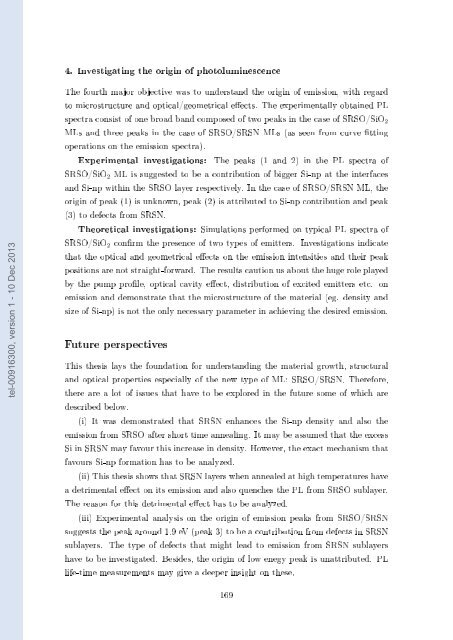Films minces à base de Si nanostructuré pour des cellules ...
Films minces à base de Si nanostructuré pour des cellules ...
Films minces à base de Si nanostructuré pour des cellules ...
You also want an ePaper? Increase the reach of your titles
YUMPU automatically turns print PDFs into web optimized ePapers that Google loves.
4. Investigating the origin of photoluminescence<br />
tel-00916300, version 1 - 10 Dec 2013<br />
The fourth major objective was to un<strong>de</strong>rstand the origin of emission, with regard<br />
to microstructure and optical/geometrical eects. The experimentally obtained PL<br />
spectra consist of one broad band composed of two peaks in the case of SRSO/<strong>Si</strong>O 2<br />
MLs and three peaks in the case of SRSO/SRSN MLs (as seen from curve tting<br />
operations on the emission spectra).<br />
Experimental investigations: The peaks (1 and 2) in the PL spectra of<br />
SRSO/<strong>Si</strong>O 2 ML is suggested to be a contribution of bigger <strong>Si</strong>-np at the interfaces<br />
and <strong>Si</strong>-np within the SRSO layer respectively. In the case of SRSO/SRSN ML, the<br />
origin of peak (1) is unknown, peak (2) is attributed to <strong>Si</strong>-np contribution and peak<br />
(3) to <strong>de</strong>fects from SRSN.<br />
Theoretical investigations: <strong>Si</strong>mulations performed on typical PL spectra of<br />
SRSO/<strong>Si</strong>O 2 conrm the presence of two types of emitters. Investigations indicate<br />
that the optical and geometrical eects on the emission intensities and their peak<br />
positions are not straight-forward. The results caution us about the huge role played<br />
by the pump prole, optical cavity eect, distribution of excited emitters etc. on<br />
emission and <strong>de</strong>monstrate that the microstructure of the material (eg. <strong>de</strong>nsity and<br />
size of <strong>Si</strong>-np) is not the only necessary parameter in achieving the <strong>de</strong>sired emission.<br />
Future perspectives<br />
This thesis lays the foundation for un<strong>de</strong>rstanding the material growth, structural<br />
and optical properties especially of the new type of ML: SRSO/SRSN. Therefore,<br />
there are a lot of issues that have to be explored in the future some of which are<br />
<strong>de</strong>scribed below.<br />
(i) It was <strong>de</strong>monstrated that SRSN enhances the <strong>Si</strong>-np <strong>de</strong>nsity and also the<br />
emission from SRSO after short time annealing. It may be assumed that the excess<br />
<strong>Si</strong> in SRSN may favour this increase in <strong>de</strong>nsity. However, the exact mechanism that<br />
favours <strong>Si</strong>-np formation has to be analyzed.<br />
(ii) This thesis shows that SRSN layers when annealed at high temperatures have<br />
a <strong>de</strong>trimental eect on its emission and also quenches the PL from SRSO sublayer.<br />
The reason for this <strong>de</strong>trimental eect has to be analyzed.<br />
(iii) Experimental analysis on the origin of emission peaks from SRSO/SRSN<br />
suggests the peak around 1.9 eV (peak 3) to be a contribution from <strong>de</strong>fects in SRSN<br />
sublayers. The type of <strong>de</strong>fects that might lead to emission from SRSN sublayers<br />
have to be investigated. Besi<strong>de</strong>s, the origin of low enegy peak is unattributed. PL<br />
life-time measurements may give a <strong>de</strong>eper insight on these.<br />
169
















